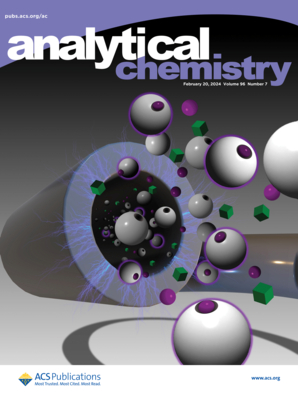利用CRISPR增强相敏表面等离子体共振成像技术检测原子摩尔核酸。
IF 6.7
1区 化学
Q1 CHEMISTRY, ANALYTICAL
引用次数: 0
摘要
随着临床诊断和病原体监测对实时、无扩增、无标记核酸检测的需求日益增长,传统的核酸检测方法由于灵敏度有限、动态范围窄、检测低浓度核酸和单核苷酸突变困难等原因,往往存在不足。为了解决这些挑战,我们开发了一种聚类规则间隔短回文重复(CRISPR)增强相位询问表面等离子体共振成像(CRISPR- pspri)传感器,该传感器采用相位延迟调制来高度敏感地提取SPR相位信号,并采用波长扫描策略来扩展其动态范围。通过利用CRISPR-Cas12a进行目标DNA识别并激活反式切割以切割ssdna连接的金纳米颗粒探针,我们的平台将来自低浓度DNA的极弱信号转换为易于检测的切割信号。该系统灵敏度为1.436 × 10-6 RIU,动态范围为0.0111 RIU,成功检测了SARS-CoV-2 Omicron BA.2变异和猴痘病毒的特异性DNA,并且可以检测到1 aM以内的单核苷酸突变。这一突破提供了一种实时、高通量、超灵敏的核酸检测方法,有望在临床诊断和病原体监测方面取得重大进展。本文章由计算机程序翻译,如有差异,请以英文原文为准。
Attomolar Nucleic Acid Detection Using CRISPR Enhanced Phase-Sensitive Surface Plasmon Resonance Imaging.
Driven by the growing need for real-time, amplification-free, and label-free nucleic acid detection in clinical diagnostics and pathogen surveillance, traditional methods often fall short due to limited sensitivity, a narrow dynamic range, and difficulties in detecting low-concentration nucleic acids and single-nucleotide mutations. To address these challenges, we developed a clustered regularly interspaced short palindromic repeats (CRISPR) enhanced Phase-interrogation Surface Plasmon Resonance imaging (CRISPR-PSPRi) sensor that employs phase delay modulation for highly sensitive extraction of SPR phase signals and a wavelength scanning strategy to extend its dynamic range. By harnessing CRISPR-Cas12a for target DNA recognition and activating trans-cleavage to cleave ssDNA-linked gold nanoparticle probes, our platform converts extremely weak signals from low-concentration DNA into readily detectable cleavage signals. Achieving a sensitivity of 1.436 × 10-6 RIU and a dynamic range of 0.0111 RIU, this system successfully detects specific DNA from the SARS-CoV-2 Omicron BA.2 variant and monkeypox virus, and it can detect single-nucleotide mutations down to 1 aM. This breakthrough offers a real-time, high-throughput, and ultrasensitive nucleic acid detection approach, promising significant advancements in clinical diagnostics and pathogen monitoring.
求助全文
通过发布文献求助,成功后即可免费获取论文全文。
去求助
来源期刊

Analytical Chemistry
化学-分析化学
CiteScore
12.10
自引率
12.20%
发文量
1949
审稿时长
1.4 months
期刊介绍:
Analytical Chemistry, a peer-reviewed research journal, focuses on disseminating new and original knowledge across all branches of analytical chemistry. Fundamental articles may explore general principles of chemical measurement science and need not directly address existing or potential analytical methodology. They can be entirely theoretical or report experimental results. Contributions may cover various phases of analytical operations, including sampling, bioanalysis, electrochemistry, mass spectrometry, microscale and nanoscale systems, environmental analysis, separations, spectroscopy, chemical reactions and selectivity, instrumentation, imaging, surface analysis, and data processing. Papers discussing known analytical methods should present a significant, original application of the method, a notable improvement, or results on an important analyte.
 求助内容:
求助内容: 应助结果提醒方式:
应助结果提醒方式:


